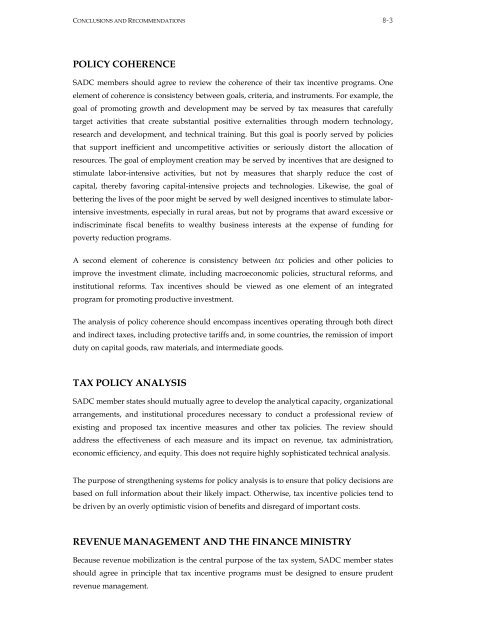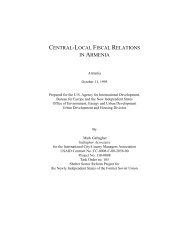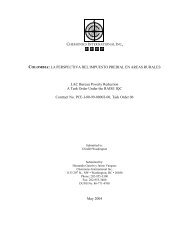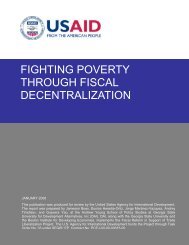Effectiveness and Economic Impact of Tax Incentives in the SADC ...
Effectiveness and Economic Impact of Tax Incentives in the SADC ...
Effectiveness and Economic Impact of Tax Incentives in the SADC ...
Create successful ePaper yourself
Turn your PDF publications into a flip-book with our unique Google optimized e-Paper software.
CONCLUSIONS AND RECOMMENDATIONS 8-3<br />
POLICY COHERENCE<br />
<strong>SADC</strong> members should agree to review <strong>the</strong> coherence <strong>of</strong> <strong>the</strong>ir tax <strong>in</strong>centive programs. One<br />
element <strong>of</strong> coherence is consistency between goals, criteria, <strong>and</strong> <strong>in</strong>struments. For example, <strong>the</strong><br />
goal <strong>of</strong> promot<strong>in</strong>g growth <strong>and</strong> development may be served by tax measures that carefully<br />
target activities that create substantial positive externalities through modern technology,<br />
research <strong>and</strong> development, <strong>and</strong> technical tra<strong>in</strong><strong>in</strong>g. But this goal is poorly served by policies<br />
that support <strong>in</strong>efficient <strong>and</strong> uncompetitive activities or seriously distort <strong>the</strong> allocation <strong>of</strong><br />
resources. The goal <strong>of</strong> employment creation may be served by <strong>in</strong>centives that are designed to<br />
stimulate labor-<strong>in</strong>tensive activities, but not by measures that sharply reduce <strong>the</strong> cost <strong>of</strong><br />
capital, <strong>the</strong>reby favor<strong>in</strong>g capital-<strong>in</strong>tensive projects <strong>and</strong> technologies. Likewise, <strong>the</strong> goal <strong>of</strong><br />
better<strong>in</strong>g <strong>the</strong> lives <strong>of</strong> <strong>the</strong> poor might be served by well designed <strong>in</strong>centives to stimulate labor-<br />
<strong>in</strong>tensive <strong>in</strong>vestments, especially <strong>in</strong> rural areas, but not by programs that award excessive or<br />
<strong>in</strong>discrim<strong>in</strong>ate fiscal benefits to wealthy bus<strong>in</strong>ess <strong>in</strong>terests at <strong>the</strong> expense <strong>of</strong> fund<strong>in</strong>g for<br />
poverty reduction programs.<br />
A second element <strong>of</strong> coherence is consistency between tax policies <strong>and</strong> o<strong>the</strong>r policies to<br />
improve <strong>the</strong> <strong>in</strong>vestment climate, <strong>in</strong>clud<strong>in</strong>g macroeconomic policies, structural reforms, <strong>and</strong><br />
<strong>in</strong>stitutional reforms. <strong>Tax</strong> <strong>in</strong>centives should be viewed as one element <strong>of</strong> an <strong>in</strong>tegrated<br />
program for promot<strong>in</strong>g productive <strong>in</strong>vestment.<br />
The analysis <strong>of</strong> policy coherence should encompass <strong>in</strong>centives operat<strong>in</strong>g through both direct<br />
<strong>and</strong> <strong>in</strong>direct taxes, <strong>in</strong>clud<strong>in</strong>g protective tariffs <strong>and</strong>, <strong>in</strong> some countries, <strong>the</strong> remission <strong>of</strong> import<br />
duty on capital goods, raw materials, <strong>and</strong> <strong>in</strong>termediate goods.<br />
TAX POLICY ANALYSIS<br />
<strong>SADC</strong> member states should mutually agree to develop <strong>the</strong> analytical capacity, organizational<br />
arrangements, <strong>and</strong> <strong>in</strong>stitutional procedures necessary to conduct a pr<strong>of</strong>essional review <strong>of</strong><br />
exist<strong>in</strong>g <strong>and</strong> proposed tax <strong>in</strong>centive measures <strong>and</strong> o<strong>the</strong>r tax policies. The review should<br />
address <strong>the</strong> effectiveness <strong>of</strong> each measure <strong>and</strong> its impact on revenue, tax adm<strong>in</strong>istration,<br />
economic efficiency, <strong>and</strong> equity. This does not require highly sophisticated technical analysis.<br />
The purpose <strong>of</strong> streng<strong>the</strong>n<strong>in</strong>g systems for policy analysis is to ensure that policy decisions are<br />
based on full <strong>in</strong>formation about <strong>the</strong>ir likely impact. O<strong>the</strong>rwise, tax <strong>in</strong>centive policies tend to<br />
be driven by an overly optimistic vision <strong>of</strong> benefits <strong>and</strong> disregard <strong>of</strong> important costs.<br />
REVENUE MANAGEMENT AND THE FINANCE MINISTRY<br />
Because revenue mobilization is <strong>the</strong> central purpose <strong>of</strong> <strong>the</strong> tax system, <strong>SADC</strong> member states<br />
should agree <strong>in</strong> pr<strong>in</strong>ciple that tax <strong>in</strong>centive programs must be designed to ensure prudent<br />
revenue management.











